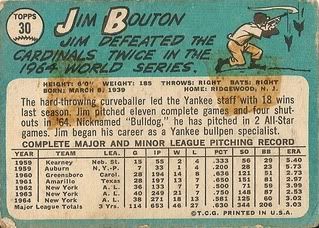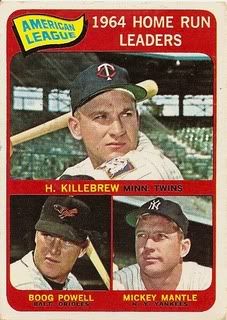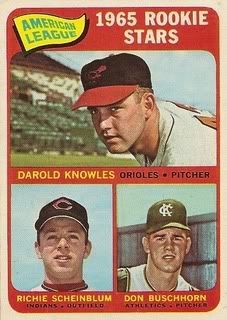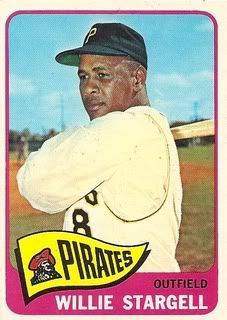
Fun facts about Jim Bouton:
-Jim was born in Newark, NJ and attended Western Michigan University before signing with the Yankees in 1959.
-The young pitcher, known as "Bulldog", went 13-7 with a 2.97 ERA at AA Amarillo in 1961 and earned a spot on the big league team the following spring. As a rookie, he made 16 starts and 20 relief appearances, going 7-7 with a 3.99 ERA and 2 saves. He did not appear in the World Series vs. San Francisco.
-1963 was a breakout year for the sophomore, as he went 21-7 with 12 complete games and team bests in ERA (2.53) and shutouts (6). He took a hard-luck loss in Game 3 of the World Series, dropping a 1-0 decision to Dodger star Don Drysdale.
-Bouton followed up with an 18-13 mark and a 3.02 ERA and 1.06 WHIP in 1964. He dazzled in the World Series, winning both of his starts and allowing 4 runs (3 earned) in 17.1 innings for a 1.56 ERA.
-His intellectual, sarcastic, and iconoclastic behavior frequently made him conspicuous in the clubhouse, and arm troubles in the mid-1960s made him expendable in the eyes of the Yankees. While pitching for AAA Seattle in 1968, he began throwing a knuckleball in order to be effective. He was to spend much of the 1969 season in the Pacific Northwest, but this time with the Pilots, a first-year club in the American League. Used mostly in relief, he went 2-1 with a save and a 3.91 ERA. He was traded to Houston for the stretch run and had a 4.11 ERA in 30.2 innings for the Astros.
-Of course, Bouton kept a running diary of that 1969 season, and it was published as "Ball Four". It was a best-seller and a groundbreaking look inside major league clubhouses. The "old-boys" network in baseball was furious, with players and executives alike feeling that he had abused trust and privacy and painted the sport and its people in an unflattering light. He put up a 5.40 ERA in 29 games with the Astros in 1970, and following the publication of his book, could not latch on with another team.
-Throughout the 1970s, Jim continued pitching in semipro ball. He got a minor league deal from Bill Veeck in 1977, and the following year the similarly free-thinking Ted Turner signed the knuckleballer. He made it all the way back to the big leagues in September 1978, making 5 starts for a bad Braves team. The 39-year-old went 1-3 with a 4.97 ERA, earning his only win with a single unearned run allowed in 6 innings on September 14 against the Giants.
-In parts of 10 seasons, he was 62-63 with 6 saves and a 3.57 ERA.
-He's had a varied and fascinating life outside of the lines. He wrote several more books, both fiction and non-fiction, and during the 1970s he dabbled in acting, co-starring in the 1973 film The Long Goodbye and co-writing and appearing in a short-lived 1976 sitcom based on "Ball Four". He also spent a few years as a sportscaster in New York and invented several products including Big League Chew, bubble gum that was shaped and packaged like chewing tobacco.
-You can read more about Jim at his official website. By the way, he reconciled with Mickey Mantle shortly before the slugger's death in 1995, and the Yankees finally welcomed him back to Old Timers' Day in 1998.


































